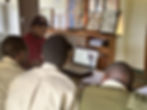Bridging Conservation Across Borders: Drs. David and Charline’s First Journey to Kenya
- Charline Rutagengwa & David Murenzi
- Aug 22, 2024
- 4 min read
Updated: Apr 17
Our Rwandan-based vets, Drs. David and Charline, share their insights from their first trip to Kenya. Supported by Conservation Nation’s People & Pachyderms Collective, this trip focused on broadening their experience and expanding their knowledge of elephant and rhino health, while also fostering collaboration between our conservation projects in Rwanda and Kenya.
During our recent trip to Kenya, we had the opportunity to engage in a variety of conservation activities at Ol Jogi Conservancy, Ol Pejeta Conservancy, and Twala-Tenebo Cultural Manyatta. The purpose of this trip was to enhance our understanding of wildlife conservation through the perspective of a private conservancy, undergo training in veterinary medicine, and deliver educational outreach sessions on One Health principles. The insights gained during this trip will be instrumental in informing future conservation and veterinary initiatives at our home base in Rwanda.

A Week at Ol Jogi Conservancy
Our first stop was the Ol Jogi Conservancy, a haven for endangered species and a leader in wildlife conservation. The conservancy is home to 22 species of ungulates, 5 large carnivores, 3 primates, and up to 400 bird species. Notably, Ol Jogi houses over 100 rhinos, including 64 critically endangered eastern black rhinos and 36 southern white rhinos. It also shelters 16% of the world’s remaining Grevy’s zebras.
During our week at Ol Jogi, we participated in the daily operations of the Wildlife Rescue Center and veterinary clinic. The rescue center plays a crucial role in rehabilitating orphaned and injured wildlife, ensuring they receive the care they need to be reintroduced into the wild. Our involvement included:
Wildlife Care: Assisted with orphaned wildlife, focusing on replicating natural habitats for successful reintroduction.
Animal Behavior: Observed behavior of wildlife housed in the rescue center, noting differences from wild counterparts in reinforcement and adaptation.
Nutritional Management: Learned about animal diets, including preparing specialized meals like ground oats for a baby black rhino.
In addition to these activities, we delivered One Health training to the Wildlife Rescue Center personnel. This training focused on visual health assessments of wild animals, zoonotic diseases, and biosecurity measures, aiming to equip the staff with the knowledge needed to monitor and care for the wildlife under their supervision.
Dr. Charline Rutagengwa meets some of Kenya's locals
Conservation Innovations at Ol Pejeta
Our next stop was Ol Pejeta Conservancy, the largest black rhino sanctuary in East Africa and the last refuge for the world’s remaining two northern white rhinos, Fatu and Najin. At the forefront of efforts to save this subspecies from extinction, the conservancy uses advanced reproductive techniques like in vitro fertilization (IVF). Scientists have successfully created and cryopreserved several northern white rhino embryos, which are stored in liquid nitrogen for future implantation into surrogate southern white rhino mothers.
This visit highlighted the critical role of veterinary science in conservation. Although such complex procedures may not be feasible in Rwanda at this time, the principles we learned can be adapted to enhance our conservation efforts.

Engaging with the Twala-Tenebo Cultural Manyatta
We also visited the Twala-Tenebo Cultural Manyatta, a cooperative of over 200 women from various Maasai groups. Located in the semi-arid Laikipia plateau near Mount Kenya, this group exemplifies women’s empowerment and sustainable development. Twala is deeply involved in conservation, managing a baboon conservation area and conducting various research projects.
The visit to Twala demonstrated the crucial role women play in conservation and human-wildlife interaction, balancing cultural preservation with sustainable development—an inspiring model for similar initiatives.
Hands-on Training at North Kenya Veterinary Clinic
The final part of Charline’s journey took her to the North Kenya Veterinary Clinic in Nanyuki, where she underwent a two-week training program. This mixed animal veterinary practice is equipped with state-of-the-art facilities, including hospital kennels, a surgical theater, ambulatory services, digital x-rays, ultrasound, endoscopy, and dental services.
During her internship, she assisted with several cases, including equine squamous cell carcinoma, bovine fetotomy, canine osteosarcoma, Cushing’s disease, ranula in a dog, canine Babesia, and various wound surgeries. This experience greatly expanded Charline’s veterinary skills, working in an environment that attends to challenging veterinary cases.

Building Capacity and Lessons Learned in Kenya
A significant part of our trip involved delivering One Health and wildlife health lectures, thereby expanding our training efforts from Rwanda to Kenya. At Ol Jogi Conservancy, we trained animal caretakers on visual health assessments, One Health principles, and zoonotic diseases. The trainees' enthusiasm, including one trainee who took the initiative to extend the training to 35 additional staff, highlighted the value of ongoing education and peer-to-peer knowledge transfer in conservation.
Our overall experience in Kenya was profoundly enriching, providing insights into integrating conservation and veterinary science. From hands-on wildlife care at Ol Jogi Conservancy to advanced reproductive techniques at Ol Pejeta, and community-driven conservation at Twala-Tenebo Cultural Manyatta, the lessons learned will guide our future efforts. We return to Rwanda inspired to apply these insights.








